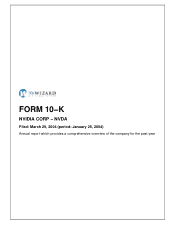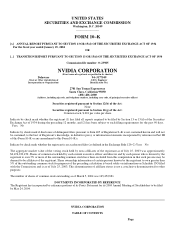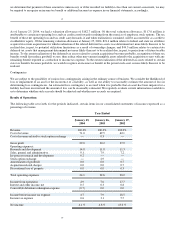NVIDIA 2004 Annual Report Download - page 9
Download and view the complete annual report
Please find page 9 of the 2004 NVIDIA annual report below. You can navigate through the pages in the report by either clicking on the pages listed below, or by using the keyword search tool below to find specific information within the annual report.
retailers, system integrators or OEMs as motherboard and add−in board solutions. Our hardware and software development teams
work closely with certification agencies, Microsoft Windows Hardware Quality Labs and our OEM customers to ensure that both our
boards and software drivers are certified for inclusion in the OEMs’ products.
5
Inventory and Working Capital
Our management focuses considerable attention on managing our inventories and other working−capital−related items. We
manage inventories by communicating with our customers and then using our industry experience to forecast demand on a
product−by−product basis. We then place manufacturing orders for our products that are based on this forecasted demand. The
quantity of products actually purchased by our customers as well as shipment schedules are subject to revisions that reflect changes in
both the customers’ requirements and in manufacturing availability. We maintain substantial inventories of our products because t he
semiconductor industry is characterized by short lead time orders and quick delivery schedules.
Research and Development
We believe that the continued introduction of new and enhanced products designed to deliver leading 3D graphics, high definition
video, audio, ultra−low power communications and networking performance and features is essential to our future success. Our
research and development strategy is to focus on concurrently developing multiple generations of GPUs, MCPs and UMPs using
independent design teams. Our research and development efforts are performed within specialized groups consisting of software
engineering, hardware engineering, very large scale integration, or VLSI, design engineering, process engineering, architecture and
algorithms. These groups act as a pipeline designed to allow the efficient simultaneous development of multiple generations of
products.
A critical component of our product development effort is our partnerships with leaders in the computer aided design, or CAD,
industry. We invest significant resources in the development of relationships with industry leaders, including Cadence Design
Systems, Inc., IKOS Systems, Inc. and Synopsys, Inc., often assisting these companies in the product definition of their new products.
We believe that forming these relationships and utilizing next−generation development tools to design, simulate and verify our
products will help us remain at the forefront of the 3D graphics market and develop products that utilize leading−edge technology on a
rapid basis. We believe this approach assists us in meeting the new design schedules of PC manufacturers.
We have substantially increased our engineering and technical resources and have 1,057 full−time employees engaged in research and
development as of January 25, 2004, compared to 832 employees as of January 26, 2003. During fiscal years 2004, 2003 and 2002, we
incurred research and development expenditures of $270.0 million, $224.9 million and $154.8 million, respectively.
Competition
The market for GPUs, MCPs and UMPs for PCs and handhelds is intensely competitive and is characterized by rapid technological
change, evolving industry standards and declining average selling prices. We believe that the principal competitive factors in this
market are performance, breadth of product offerings, access to customers and distribution channels, backward−forward software
support, conformity to industry standard APIs, manufacturing capabilities, price of digital media processors and total system costs of
add−in boards or motherboards. We expect competition to increase both from existing competitors and new market entrants with
products that may be less costly than ours, or may provide better performance or additional features not provided by our products.
Our primary source of competition is from companies that provide or intend to provide GPU, MCP and UMP solutions for the PC and
handheld segments. Our competitors include the following:
· suppliers of MCPs that incorporate a combination of 3D graphics, networking, audio, communications and Input/Output, or I/O,
functionality as part of their existing solutions, such as ATI Technologies, Inc., or ATI, Intel Corporation, or Intel, Silicon Integrated
Systems, Inc., and VIA Technologies, Inc., or VIA;
· suppliers of standalone desktop GPUs that incorporate 3D graphics functionality as part of their existing solutions, such as ATI,
Creative Technology, Matrox Electronics Systems Ltd. and XGI Technology, Inc.,;
· suppliers of standalone notebook GPUs that incorporate 3D graphics functionality as part of their existing solutions, such as ATI,
Silicon Motion Corporation, and the joint venture of a division of SONICblue Incorporated (formerly S3 Incorporated) and VIA; and
· suppliers of UMPs for handheld devices that incorporate advanced graphics functionality as part of their existing solutions, such as
ATI and Seiko−Epson.
If and to the extent we offer products outside of the personal computer, consumer electronics and handheld segments, we may face
competition from some of our existing competitors, as well as from companies with which we currently do not compete. We cannot
accurately predict if we will compete successfully in any new segments we may enter.






















